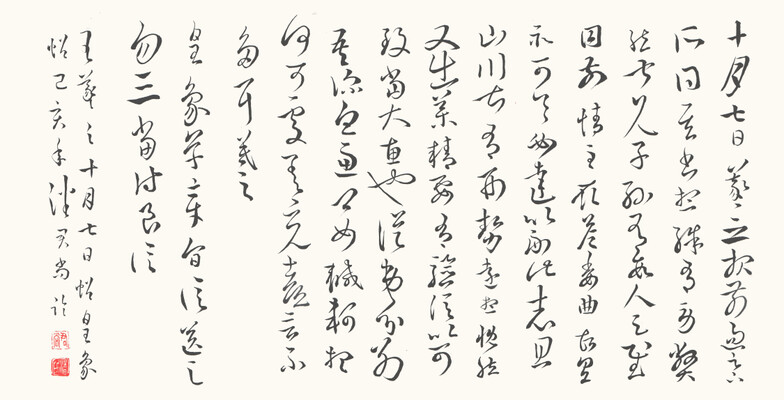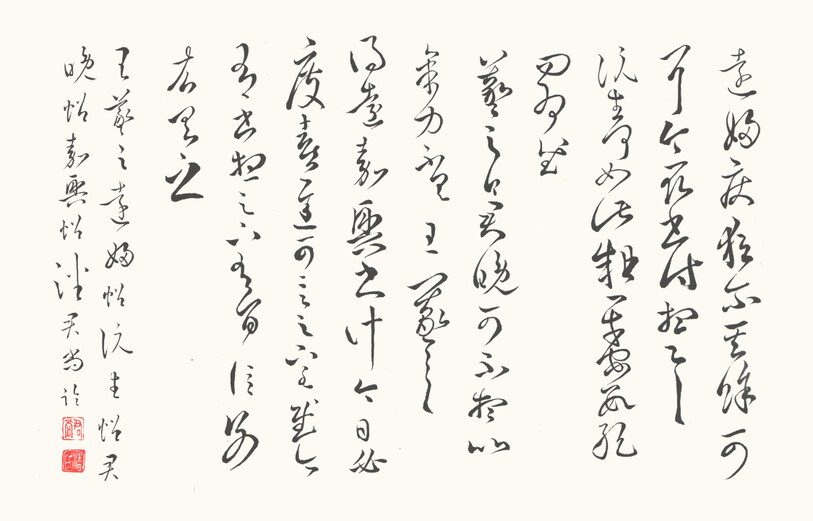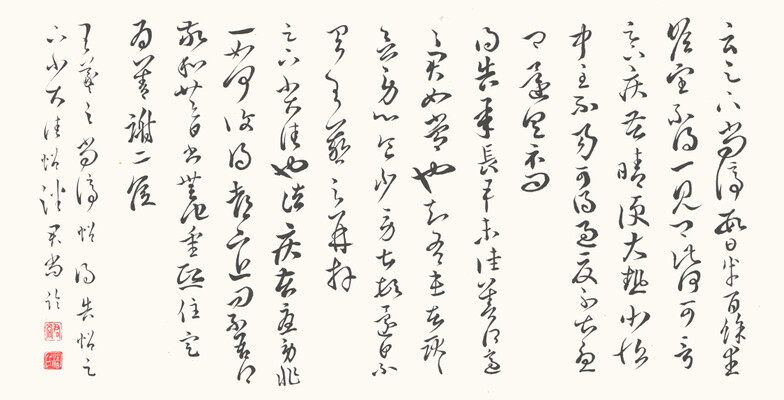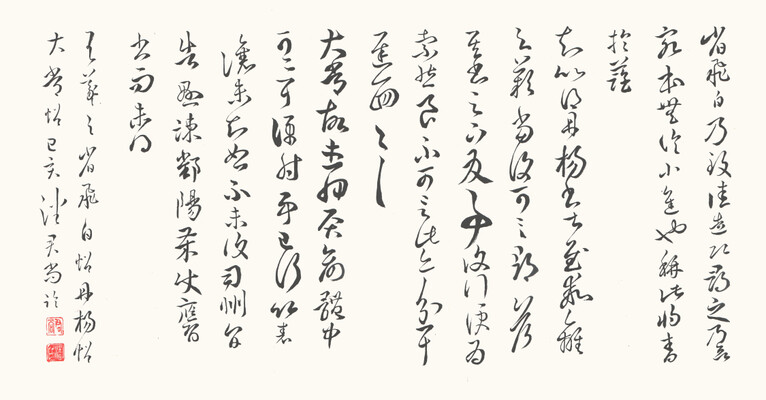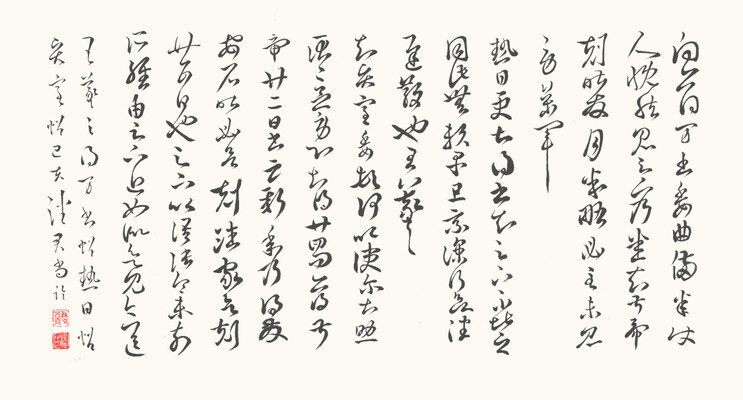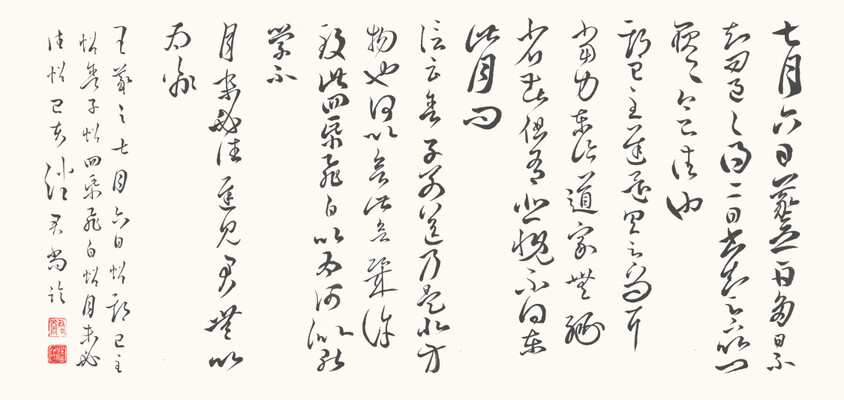Galleries and Translations > Models of Masterpieces > Models of miscellaneous Masterpieces by Wang Xizhi (VIII) 臨王羲之諸法帖 (第八部份)
Models of miscellaneous Exemplary Masterpieces by Wang Xizhi (VIII) 臨王羲之諸法帖 (第八部份)
Historical information
(I)
Wang Xizhi (王羲之) is often considered to be the most outstanding Chinese calligrapher of all time and is regarded as “The Sage of Calligraphy (書聖)” in China and Japan. Born in 303AD in an upper-class aristocratic family, Wang Xizhi started learning Chinese calligraphy at the age of seven from the renowned calligrapher Wei Shuo (衛鑠 or 衛夫人, 272-349AD). His father, Wang Kuang (王曠, ?-?AD), was a government prefecture chief (太守) and was also a calligrapher. His uncle, Wang Dao (王導, 276-339AD), was the prime minister (丞相) during the reign of Emperor Cheng of the Eastern Jin Dynasty (晉成帝, 321-342AD ). Further biographic information of Wang can be seen on my page regarding Lanting Xu (蘭亭帖).
(II)
The calligraphies presented below are my models of Wang Xizhi's handwriting found in Chunhua Imperial Archive of Calligraphy Exemplars (《淳化閣帖》). Supposedly, these handwritings were short letters and memos scribed by Wang. Although their authenticities are questionable, they are still often regarded as Exemplary Masterpieces (法帖) for calligraphers to study and observe. In the art of Chinese calligraphy, "帖(pronounced as Tie)" refers to an exemplary work that should be studied by all .
(III)
Since the originals in the Chunhua Imperial Archive of Calligraphy Exemplars (《淳化閣帖》) can be parts of or whole letters/memos scribed by Wang, translations that are provided below, if available, may not be entirely precise, for they can be interpreted out of context. Further, whether Wang had actually scribed them remains questionable. Accordingly, scholars should be wary of using these as authentic historical references.
A model of Shi Yue Qī Ri Tie (十月七日帖) and Huang Xiang Tie(皇象帖)
35 X 69 cm
Click to Enlarge. Reserved, not available in shop.
Shi Yue Qī Ri Tie (十月七日帖) :
Original Classical Chinese: 十月七日羲之報:前過足下所,得其書,想殊有勞弊。然叔兄子孫有數人,足慰目前。情至取答委曲,故具示。可令必達,以副此志。且山川甚有形勢,遠想慨然。又出藥精,要有驗。信比可致,當大惠也。從弟分別,吾深憂慮。卿女轗軻,想何可處?差充熹言不多耳。羲之。
English: NA. The entire phrase may not be translated, for the context in which it was written is unknown or uncertain.
Huang Xiang Tie(皇象帖):
Original Classical Chinese: 皇象草章,旨信送之,勿三。當付良信。
English: NA. The entire phrase may not be translated, for the context in which it was written is unknown or uncertain.
A model of Yuan Fu Tie (遠婦帖), Ruan Sheng Tie (阮生帖), Jun Wan Tie (君晚帖), and Jia Xing Tie (嘉興帖)
35 X 55 cm
Click to Enlarge. Reserved, not available in shop.
Yuan Fu Tie (遠婦帖):
Original Classical Chinese: 遠婦疾猶爾,其餘可耳。今取書付,想具。
English: NA. The entire phrase may not be translated, for the context in which it was written is unknown or uncertain.
Ruan Sheng Tie (阮生帖):
Original Classical Chinese: 阮生何如?此粗平安。數問,為慰。
English: NA. The entire phrase may not be translated, for the context in which it was written is unknown or uncertain.
Jun Wan Tie (君晚帖):
Original Classical Chinese: 君晚可不?想比果?力不具。王羲之(白)。
English: NA. The entire phrase may not be translated, for the context in which it was written is unknown or uncertain.
Jia Xing Tie (嘉興帖):
Original Classical Chinese: 得遠嘉興書。計今日必度。喜遲可言。足下至慰,今有書想足下有旨信。別告具之。
English: NA. The entire phrase may not be translated, for the context in which it was written is unknown or uncertain.
A model of Shang Ting Tie (尚停帖), De Gao Tie (得告帖), and Zu Xia Xiao Da Jia Tie(足下小大佳帖)
35 X 69 cm
Click to Enlarge. Reserved, not available in shop.
Shang Ting Tie (尚停帖):
Original Classical Chinese: 雲足下尚停數日,半百餘(裏)〔武〕瞻望,不得一見卿,此何可言。足下疾苦,晴便大熱。如恒中至不易,可得過夏不?甚憂卿,還具示問。
English: NA. The entire phrase may not be translated, for the context in which it was written is unknown or uncertain.
De Gao Tie (得告帖):
Original Classical Chinese: 得告。承長平未佳善。得適君如常也。知有患者。耿耿。念勞心食少。甚頓。還白不具。王羲之再拜。
English: NA. The entire phrase may not be translated, for the context in which it was written is unknown or uncertain.
Zu Xia Xiao Da Jia Tie(足下小大佳帖):
Original Classical Chinese: 足下小大佳也。諸疾苦憂,勞非一,如何?復得都下近問不?吾得敬和廿三日書,無他,重熙住定為善。謝二侯。
English: NA. The entire phrase may not be translated, for the context in which it was written is unknown or uncertain.
De Jing Yu Tie (得敬豫帖):
Original Classical Chinese: 得敬豫九日問,故進退憂之深。
English: NA. The entire phrase may not be translated, for the context in which it was written is unknown or uncertain.
A model of Sheng Fei Bai Tie (省飛白帖), Dan Yang Tie (丹楊帖), and Da Chang Tie (大常帖)
35 X 67 cm
Click to Enlarge. Reserved, not available in shop.
Sheng Fei Bai Tie (省飛白帖):
Original Classical Chinese: 省飛白,乃致佳。造次尋之,乃欲窮本。無論小進也,稱此將青於藍。
English: NA. The entire phrase may not be translated, for the context in which it was written is unknown or uncertain.
Dan Yang Tie (丹楊帖):
Original Classical Chinese: 知比得丹楊書,甚慰。乖離之歎,當復可言。尋答其書,足下反事復行。便爲索然,良不可言。此亦分耳。遲面具具。
English: NA. The entire phrase may not be translated, for the context in which it was written is unknown or uncertain.
Da Chang Tie (大常帖):
Original Classical Chinese: 大常故患胛,灸愈,體中可可耳。仆射事已行。以《表》讓,未知恕不? 未複司州旨告,懸悚。鄱陽歲使,應有書,而未得。
English: NA. The entire phrase may not be translated, for the context in which it was written is unknown or uncertain.
A model of De Wan Shu Tie (得萬書帖), Re Ri Tie (熱日帖), and Xian Shi Tie (賢室帖)
35 X 65 cm
Click to Enlarge. Reserved, not available in shop.
De Wan Shu Tie (得萬書帖):
Original Classical Chinese: 向亦得萬書,委曲備悉,使人慨然。見足下,乃悉知。叔虎剋昨發,月半略必至。未見,勞參軍。
English: NA. The entire phrase may not be translated, for the context in which it was written is unknown or uncertain.
Re Ri Tie (熱日帖):
Original Classical Chinese: 熱日更甚。得書,知足下不堪之,同此無賴。早且乘涼,行欲往,遲散也。王羲之。
English: NA. The entire phrase may not be translated, for the context in which it was written is unknown or uncertain.
Xian Shi Tie (賢室帖):
Original Classical Chinese: 知賢室委頓,何以使爾,甚助,耿耿,念勞心。知得廿四問,甚得虎廿二日書,雲新年乃得發。安石昨必欲克潘家,欲克,廿五日也。足下以語張令未?前所經由,足下近如似欲見。
English: NA. The entire phrase may not be translated, for the context in which it was written is unknown or uncertain.
A model of Qi Yue Liu Ri Tie (七月六日帖), Qi Yi Zhi Tie (期已至帖), She Zi Tie (舍子帖), Sì Zhi Fei Bai Tie (四紙飛白帖), Yue Mo Bì Jia Tie (月末必佳帖)
35 X 74 cm
Click to Enlarge. Reserved, not available in shop.
Qi Yue Liu Ri Tie (七月六日帖):
Original Classical Chinese: 七月六日羲之白:多日不知問,邑邑。得二日書,知足下昨問,耿耿。今已佳也。
English: NA. The entire phrase may not be translated, for the context in which it was written is unknown or uncertain.
Qi Yi Zhi Tie (期已至帖):
Original Classical Chinese: 期已至,遲還。具足下問耳,當力東沿,道家無緣省苦,但有悲慨,不得東。此月問。
English: NA. The entire phrase may not be translated, for the context in which it was written is unknown or uncertain.
She Zi Tie (舍子帖):
Original Classical Chinese: 信雲,舍子別送。乃是北方物也。何以欲此,欲幾許?
English: NA. The entire phrase may not be translated, for the context in which it was written is unknown or uncertain.
Sì Zhi Fei Bai Tie (四紙飛白帖):
Original Classical Chinese: 致此四紙飛白,以為何以?能學不?
English: NA. The entire phrase may not be translated, for the context in which it was written is unknown or uncertain.
Yue Mo Bì Jia Tie (月末必佳帖):
Original Classical Chinese: 月末必佳 ?還見君無以為喻。
English: NA. The entire phrase may not be translated, for the context in which it was written is unknown or uncertain.
